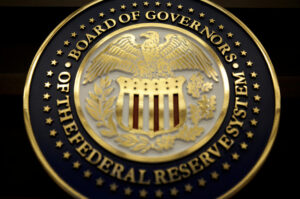




Philippines Trade Update: Exports momentum continues
 DOWNLOAD
DOWNLOAD

Quarterly Economic Growth Release: More BSP cuts to come
 DOWNLOAD
DOWNLOAD

Monthly Economic Update: Fed catches up
 DOWNLOAD
DOWNLOAD


More Fed hikes may put pressure on peso

FURTHER TIGHTENING by the US Federal Reserve may put pressure on the Philippine peso cause potential fund outflows in the coming months, analysts said, adding that more rate hikes from the Bangko Sentral ng Pilipinas (BSP) could help cushion the blow.
US Federal Reserve Chairman Jerome H. Powell last week said the US central bank would likely raise interest rates more than expected to control inflation. This led market players to speculate that the terminal rate might peak at 6% this year.
“This will likely place pressure on the peso and other currencies. This is because of yield differentials compared with the US,” MUFG Senior Currency Analyst Jeff Ng said in an e-mail.
He said the US 10-year yields are higher than Malaysia’s and Thailand’s, causing some currency depreciation for both countries in the past weeks.
“Although we see potential fund outflows in the near term, we eventually expect the Fed to turn neutral. This will help to reverse some dollar strength,” Mr. Ng said.
The US Federal Reserve has increased the Fed fund rate by 450 basis points (bps) since March last year, bringing rates to 4.5-4.75%. The Fed’s next policy review is scheduled for March 21 and 22.
Further rate increases by the Philippine central bank to tame elevated inflation might help limit the yield differentials between the country and the US, Mr. Ng said.
“Given these, we expect the BSP to hike to at least 6.5% in 2023, with some chance of more rate hikes in the coming months,” Mr. Ng said.
Last month, the BSP raised its key policy rate by 50 bps to 6% — the highest in nearly 16 years. It has raised rates by 400 bps since May 2022.
Inflation is expected to remain elevated this year, with the BSP projecting a full-year average of 6.1%.
“Our constructive view on the peso against the dollar in the second half of the year has remained premised on the theme of normalization, after imbalances in the previous year,” Mr. Ng said.
He said the local currency might move within the PHP 54-to-PHP 55 against the dollar this year.
China Banking Corp. Chief Economist Domini S. Velasquez said the Fed would likely move up its terminal rate projection.
“However, we currently have a 125-bp rate differential with the Fed, and it will remain sufficient to stabilize the peso,” she said in a Viber message.
The Fed’s aggressive monetary tightening since last year has caused volatility across foreign exchange markets globally, bringing the peso to its record low of PHP 59 against the dollar in October 2022.
The peso has since rebounded, closing at PHP 54.93 on Monday, 24 centavos higher than its previous finish, Bankers Association of the Philippines data showed.
Ms. Velasquez said the “sweet spot” in 2022 was a 100-bp rate differential between the BSP and Fed, and investor sentiment has improved since then.
“This year, at the end of central banks’ tightening cycle, we expect some ‘risk on’ sentiment which will partly mitigate the rise of the dollar. We do not see a return of the PHP 59-a-dollar anymore this year even with a more hawkish Fed,” she said.
However, the country’s foreign exchange market might still experience market volatilities, as the peso is likely to weaken to as low as P57 versus the greenback this year, she added.
Moody’s Analytics Senior Economist Katrina Ell said the peso has held up relatively well against the strong dollar despite elevated inflation, ensuring the BSP will continue to hike rates for a few more months.
“This comes against a backdrop of some other economies in the region being near or close to the end of their tightening cycles,” Ms. Ell said in an e-mail.
Inflation eased for the first time in six months as it slowed to 8.6% in February from 8.7% in January. For the first two months of the year, inflation averaged 8.6%, higher than the BSP’s 6.1% forecast.
“The BSP can’t do much unless it follows the interest rate hike of the Fed. Companies that have US debt will be affected since they will be paying higher interest,” Mercantile Securities Corp. Head Trader Jeff Radley C. See said.
Regina Capital Development Corp. Head of Sales Luis A. Limlingan said there is less pressure for the BSP to raise rates due to the latest inflation report.
“So long as the peso remains within a reasonable range, the BSP will at most match the Fed, while trying to keep rates from staying elevated for long. Even if inflation control is the primary goal of the BSP, a weaker peso is also linked because this is tied to import costs,” he said.
However, First Metro Investment Corp. Head of Research Cristina S. Ulang said the US central bank is unlikely to remain hawkish amid the sudden collapse of Silicon Valley Bank (SVB).
Last week, California banking regulators shut down the bank and seized its deposits, marking the largest US banking failure since the 2008 global financial crisis.
This might also prompt slower rate hikes by the Fed if not a pause, Ms. Ulang said.
“Consequently, the pressure on BSP to hike rates won’t be as much prior to the SVB closure,” she added. — By Keisha B. Ta-asan, Reporter
This article originally appeared on bworldonline.com





 By BusinessWorld
By BusinessWorld